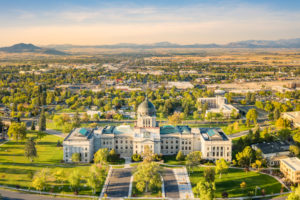What is the Montana Economic Development Industry Advancement (MEDIA) Act?
Hit series “Yellowstone” is set to film season four entirely in Montana – and it’s no longer just the epic landscapes of Big Sky Country attracting major productions like these. Effective July 1, 2019, a number of new tax incentives were put into place as part of the MEDIA Act.
The Montana State Legislature passed the Montana MEDIA Act to promote the production of feature films, television series, and commercials. The Act was intended to “generate significant economic activity for their host communities, drawing out-of-town spending, generating jobs, and supporting local businesses.” This is according to an economic impact report produced to measure the MEDIA Act success.
Once the production companies are primed to set up shop in Montana, commercial real estate advisors have to be agile in helping them secure the right space. From soundproofing to stage building, each set is unique. CRE agents with vision will be an exceptional resource for incoming productions.
Film and TV in Montana
Long before “A River Runs Through It” brought film crews (and Brad Pitt) to the Treasure State, a number of productions had already been shot here. According to the IMDb, in 1897, a documentary short titled “Tourist Train Leaving Livingston, Montana” was the first time Montana was captured on commercial film.
Since then, there have been dozens of films, shows and documentaries headquartered in Montana.
Feeling a little eerie on Going-to-the-Sun Road? You’re not alone. The opening scenes of Stanley Kubrick’s “The Shining” are aerial shots of the famous road on the east side of Glacier National Park.
Libby is home of the waterfall braved by Leonardo DiCaprio in “The Revenant.” Further east, parts of “The Horse Whisperer” were shot against the breathtaking backdrop of the Crazy Mountains.
While many of Montana’s featured productions occur outdoors, the need for wardrobe, office, and other indoor space is crucial. Balancing wide open spaces with infrastructure to support an active crew requires an agent with local knowledge.
Breaking it Down: MEDIA Act Incentives
Heralded as one of the “most competitive” film incentive programs nationwide, the MEDIA Act shows economic promise in the long term. An analysis of the Montana MEDIA Act showed nearly $50 million in total economic impact in the year after the act was passed, generated by 117 film and television productions. Local wages totaled $17 million from July 2019 – June 2020.
Depending on the production, up to 35% of related expenses in the state can be eligible for an income tax credit. In addition to the 35% credit for expenses, approved productions can receive a credit for 25% of compensation for resident crews.
(That goes up to 30% if the compensation is paid to a student enrolled in a Montana college or university and is working for college credit. If the crew is out of state, the credit is 15%.).
Productions filmed in an underserved county are eligible for a 5% tax credit. Of Montana’s 56 counties, 26 are considered underserved. Any location or equipment fee from a Montana college or university is also eligible for a 10% credit.
In 2021, a new incentive will be available for 25% of all post-production wages as well.
Montana is poised to welcome more production than ever before. We’ll keep our fingers crossed that this boon of film brings Brad back to Montana.
Looking for commercial space to suit your television or film production needs? Contact Matt Mellott, CCIM, SIOR.




